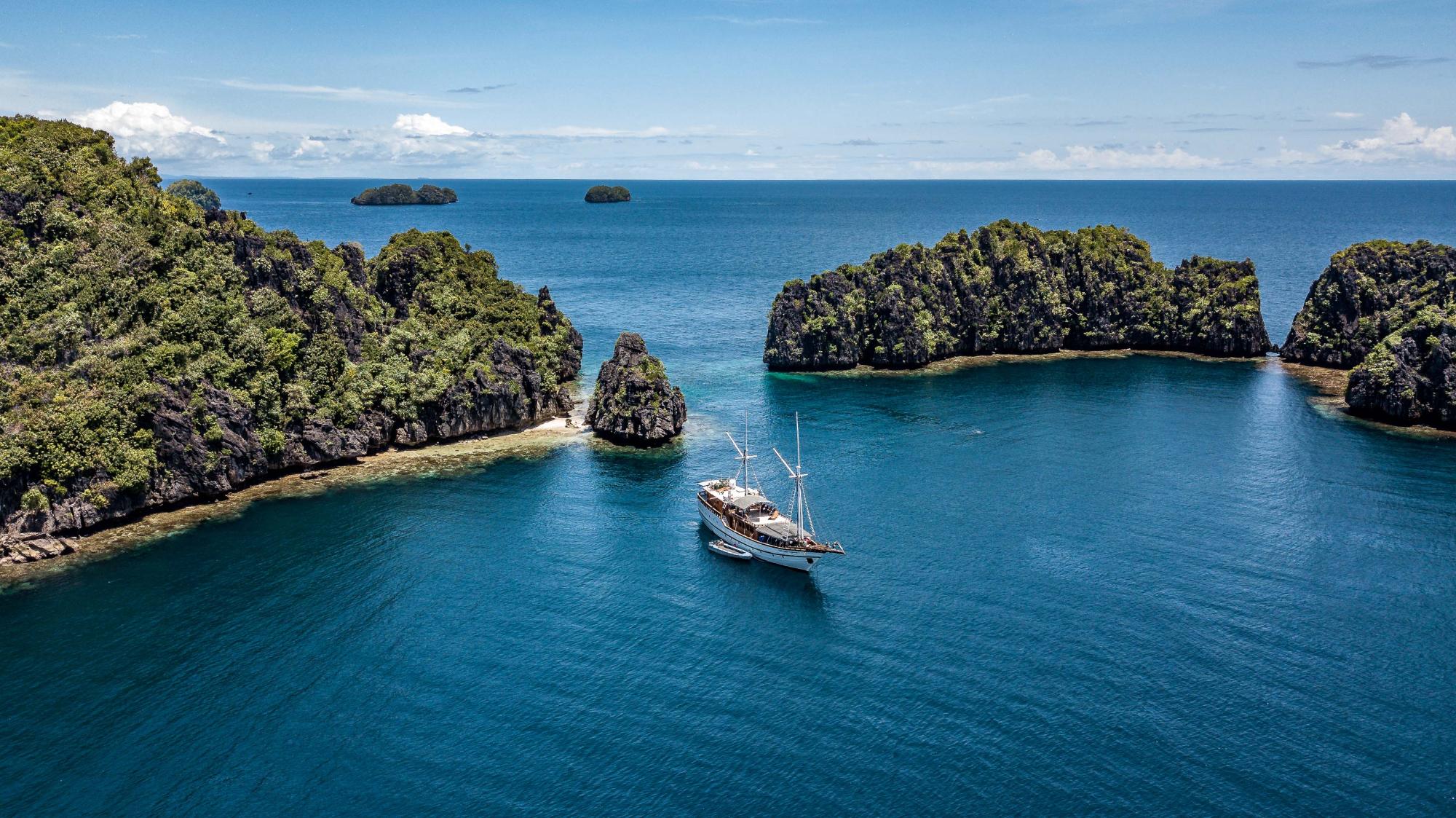The Bullseye Within The Bullseye
The late afternoon light is still bright when we roll from the dinghy into the warm waves somewhere south of Misool Island, Indonesia. Three underwater seamounts thrusting up into a blue sea, straddling the undefined boundary between the Indian and Pacific Oceans, are our diving coordinates.
“I like this site, it’s one of my favorites in Raja.” Pep, our cruise director, tells us during the dive briefing. “There are some anchovies on the pinnacles and we may see some mobulas, jacks and other predatory fish as well.”
…Some schooling anchovies would be cool to shoot…, I think to myself as I make the backward plunge.
Summersaulting to the surface, I reach up, grab my camera from the dinghy driver, and release the bubble of air in my BC floating me on the surface. In a slow free-fall to the reef-top below, I multitask: clearing ears, adjusting mask strap, checking camera settings and hand-signaling to Kevin, my dive buddy, the “ok.”
Mission essential business complete, suddenly, I’m aware of bullwhip-like cracks punctuating the white-noise of my exhaust bubbles somewhere below me. Then I remember…
When large fish or large schools of smaller fish accelerate from zero to full speed in an instant, the equivalent of an underwater sonic boom occurs leaving an audible signature that either an attack or an escape has taken place. On this seamount, at this very instant, both attacks and escapes are happening at a frenzied pitch.
Although Kevin is roughly 20 feet to my right, I lose him on our decent as he is swallowed completely by an ephemeral shadow stretching across my entire field of vision. The afternoon sun, projecting light near the surface, is reduced to nearly twilight by the shape-shifting shadow as I reach the crown of the seamount at 30 feet.
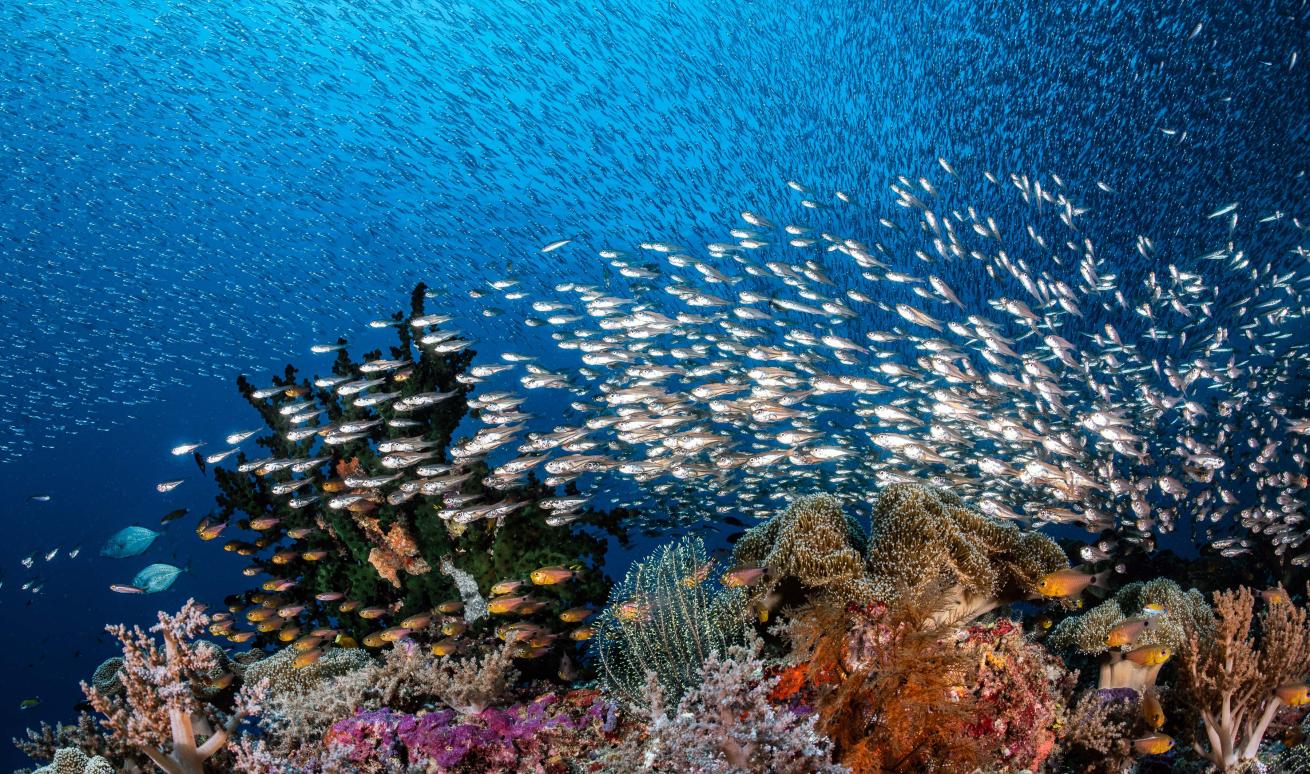
Mark B. HatterAnchovies cloud - Misool, Indonesia
In the gloaming, scores of reef predators are having their way with hapless anchovies, the source of the shadow, which numbered in the millions. Those who fail to negotiate the requisite last minute escape maneuver leave themselves fodder for the predators corralling them on the periphery.
Gobsmacked, I take it all in. The scene is surreal, it’s mesmerizing, it’s fantastical. And I quickly look for a venue from which to best shoot the ever-shifting anchovies, whose individual numbers seem to behave more like a single, amorphous being. Pep’s comment regarding “some sardines” is an obvious understatement.
Forget about mobulas, forget about predatory jacks. For the next forty-five minutes, Kevin and I move maybe 10 feet. And, only then, to check a new fore-drop to frame the main event of shifting anchovies over a twilight reef-top as it constantly reshapes before us, like an underwater aurora borealis. Although I can’t see him, the signature of his strobes, popping at regular intervals, reassures me that I’m not alone.
We are deep into our 12-day itinerary aboard the Raja Ampat Aggressor II (RAAII), which departed from Manado, Indonesia more than a week earlier after two days of epic muck diving at Lembeh Straight. With each dive site we visit, from the black sands of Lembeh, with its unrivaled micro biodiversity, to the equally biodiverse panoramic reefs off Raja Ampat, every dive scales successively in grandeur and, even audacity. Yet, according to Pep, this dive, as well as those that preceded it, are just another average day on perhaps the world’s best diving itinerary presenting the greatest in marine biodiveristy for animals large and small.
If one were to design the perfect destination dive trip for experiencing the best of the best in marine biodiversity, what would it include? As a photographer, the analogy of building a perfect three-legged chair is useful to describe the exercise. A three-legged chair is inherently stable, by definition, but to create perfection, each leg must have equality in craftsmanship, length and finish.
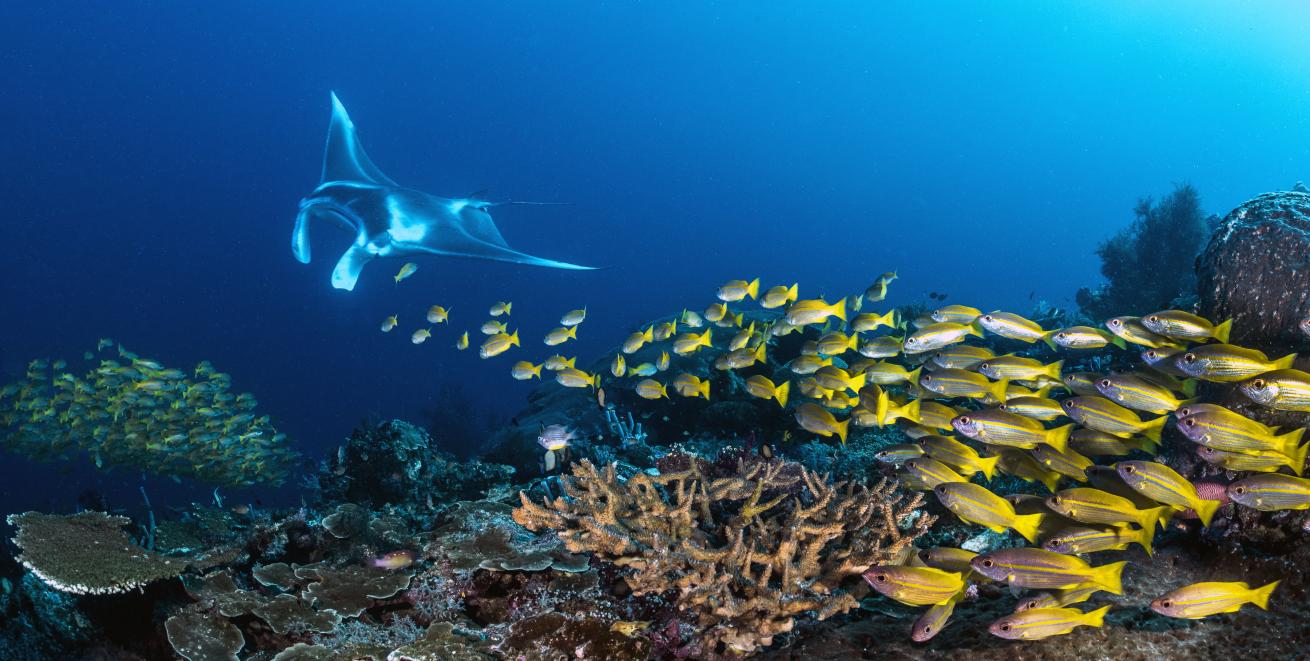
Mark B. HatterMisool manta
In my opinion, the first leg of my metaphorical chair’s design is represented by the world’s best in muck diving. “World’s best” is defined as presenting the greatest opportunities to finding the rarest and most unique animals of the tiny, micro world. The second leg is shaped toward perfection via a plethora of reefs paved with panoramic views showcasing the greatest diversity in hard and/or soft corals. Plunging walls, and expansive reef tops, all exploding in rainbow colors are a design must. Lastly, leg three must be designed via dive sites exhibiting a profusion of schooling fish. Bonus design points toward the finish product are awarded when sites can provide a real possibility of seeing mantas and whale sharks.
Within the tropical Indo-Pacific many countries can objectively compete in the perfect chair contest with proven itineraries showcasing all three exquisitely crafted legs. Indeed, all of these competitors fall within the greater bulls-eye of the Indo-Pacific’s Coral Triangle. Certainly, a diver/photographer can find “it all” at many such places in the Philippines, Papua New Guinea, or Palau. But for my model, we’re talking about the highest probability of witnessing the rarest and most diverse marine fauna with regard to speciation.
An objective approach to aid in selecting an ultimate winner in this very close competition is to look for the bullseye within the bullseye with biodiversity still the yardstick. With this added filtering lens, one nation trumps all others with a pair locations meeting the double bullseye criteria and the perfect chair analogy. That nation is Indonesia and its winning design is Lembeh Straight and Raja Ampat.
However, Lembeh Straight and Raja Ampat are geographical separated by more than 400 miles which would normally require two separate destination itineraries bridged with a commercial flight to experience them both during the same trip. Arguably, this geographic separation might be grounds for disqualification save one expeditionary option offered by the Raja Ampat Aggressor II (RAAII) with its seasonal itinerary sailing one way from the ports of Manado, entry point to diving Lembeh Straight and, Sorong, entry point to diving Raja Ampat (or this same route run in reverse).
On our trip we launched from Manado and spent two days diving the storied Lembeh Straight, where the rarest micro species can be common. Indeed, within two days I was able to capture images of several blue-ring octopus and a flamboyant cuttlefish, species which had forever eluded me until Lembeh. Kevin was equally fortunate scoring Coleman’s shrimp on a fire urchin.
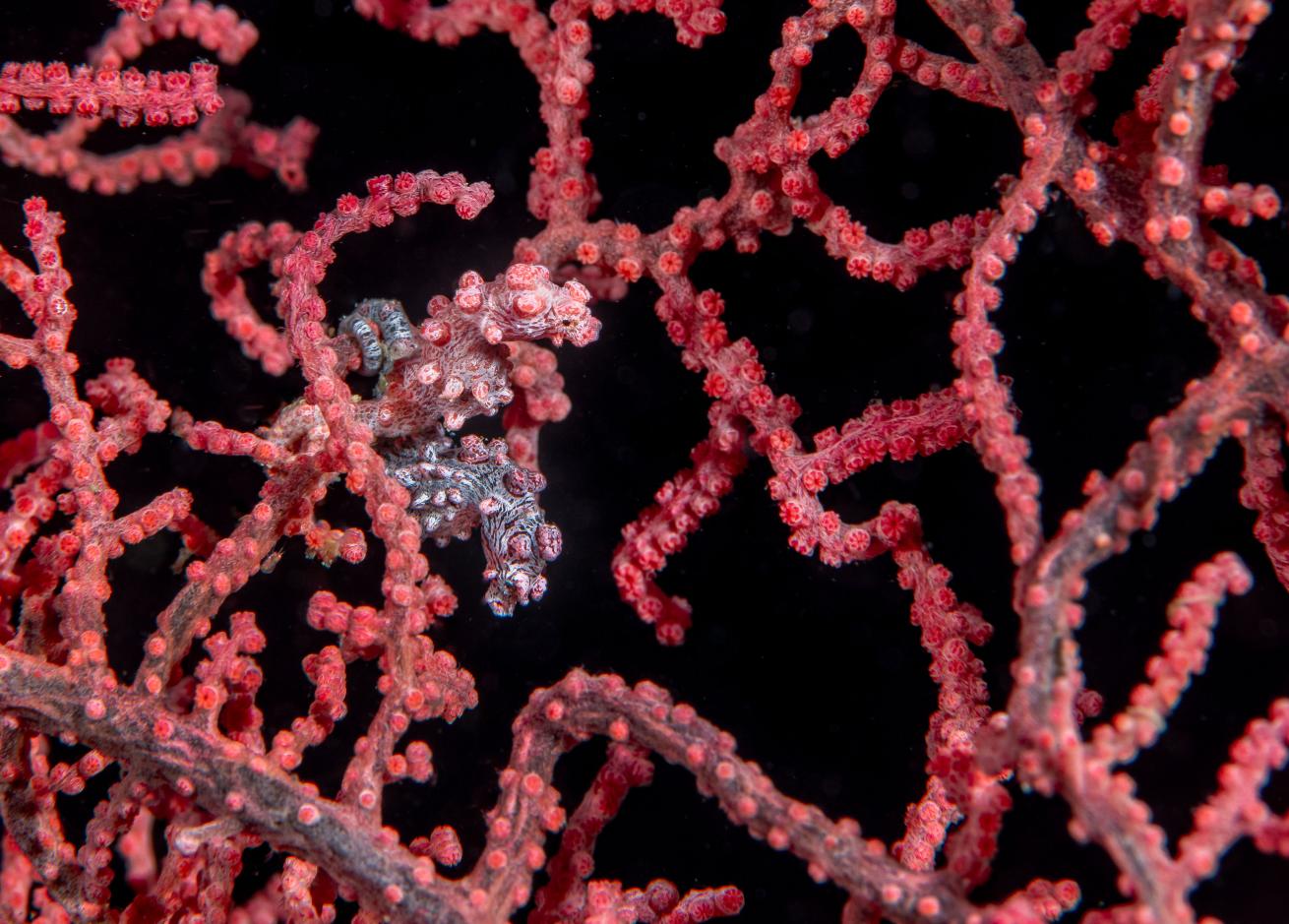
Mark B. HatterLembeh Strait marine life
At the end of two days of diving, Kevin and I had racked up images of locally endemic Banggai Cardinalfish (found nowhere else in the world), several species of ghost pipefish, pygmy seahorses in a variety of colors and countless nudibranchs ranging in size from nearly invisible to several inches in length.
A couple of days diving Lembeh Straight seemed just right. With these and other muck critters indelibly recorded on our image memory cards, our itch for macro photography was sated, paving the way for wide angle shooting for the balance of the trip.
Sailing east, the RAAII traversed the 400 miles to Raja Ampat, stopping only briefly for a few dives along the way. It was Pep’s desire to get us to Raja as quickly as possible so that the RAAII could give us the richest experience in diving the other bullseye within the bullseye which, surprisingly, varies considerably from north to south. While Lembeh Straight is small and can be completely experienced in a couple of days, Raja Ampat is an expansive region which can take weeks for one to explore it all.
The name of Raja Ampat (Raja means king, and ampat means four) comes from local mythology that tells of a woman who finds seven eggs. Four of the seven hatch becoming kings who occupy four of the regency’s largest islands; Waigeo, Bananta, Salawati and Misool (oddly, lore has the other three eggs becoming a ghost, a woman, and a stone). While the source of the name is interesting, the name “Four Kings” has metaphorical significance. The quality of the diving, with its sheer abundance and diversity of marine species within the surrounding waters, is nothing less than “royal.”
The underwater topography varies rather substantially from north to south within the regency. The two islands of Waigeo and Salawati, locally referred to as Central Raja, are characterized by warmer, shallower water, dominated by stoney corals found mostly on fringe reefs along shorelines and islands with a few notable reefs on shallow plateaus in open water between the largest islands. In fact, more than 600 species of hard corals, equaling about 75 percent of known species globally, and more than 1,700 species of reef fish can be found in Raja Ampat. Interestingly, the stoney corals have adapted to thrive in water temperature averaging between 84-86 degrees F around the central islands.
Misool at the southern end of Raja has less surrounding land mass and is characterized by slightly cooler, deeper water. Averaging 82-84 degrees, the best dive sites are underwater pinnacles and sea mounts with slopes or walls where reef crowns, smaller in area than those found in the central islands, are dominated by soft corals. While relatively drab leather corals dominate the tops of the reefs, brilliantly colored gorgonia, sea fans and dendros (Dendrophyllia sp.) dominate the walls and slopes.
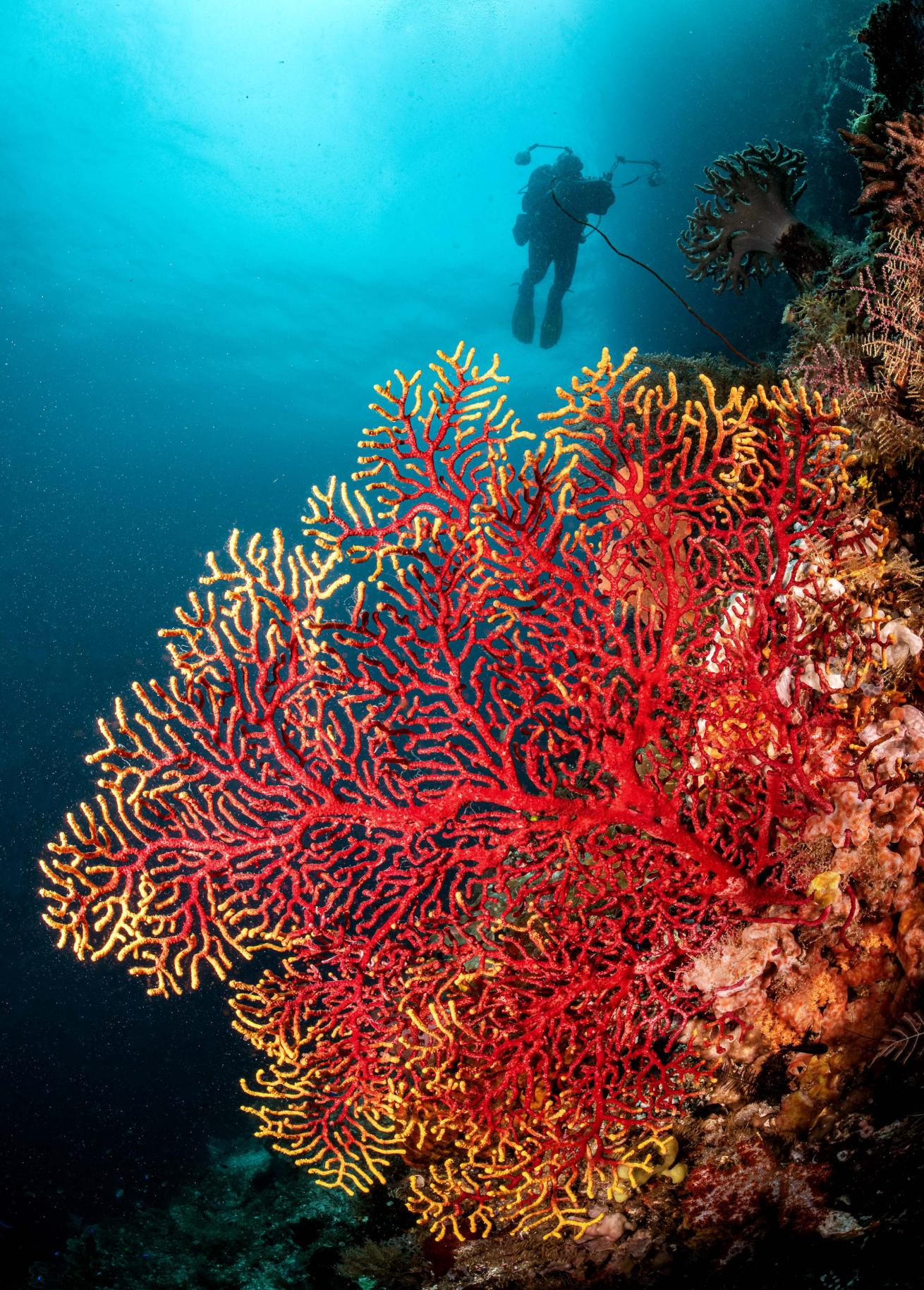
Mark B. HatterSea fan coral
Regardless of location within the regency, the convergence of two great oceans, heaving against one another on a grand scale, create strong currents washing between the islands and over offshore pinnacles with regularity. Pinched between the Indian and Pacific Oceans, the nutrient rich currents not only feed Raja’s masses but enable the proliferation of astounding numbers of fish and contribute to the extreme biodiversity by importing larval stages of everything from the two different oceans.
Accordingly, it is no surprise that Raja Ampat also presents the densest populations of fish in both species and numbers I’ve witnessed. From anchovies to fusiliers, from snappers to sweetlips, from Chromis to Anthias, every dive site we visited on the RAAII was teaming with schooling fish streaming up, down and across the reefs. For an underwater photographer, the opportunity to capture great images does not get any better!
Fortunately for the planet, notwithstanding the pressures of global impacts to the environment, the Indonesian government in collaboration with Conservation International (CI), The Nature Conservancy (TNC) and Worldwide Fund For Nature (WWF) began establishing a network of Marine Protected Areas (MPAs) under the jurisdiction of central and provincial governments in 2004. The latest MPA designation occurred in 2019 and, collectively, the MPAs now account for some 80 thousand square miles of protection including 1411 small islands, cays, and shoals that surround the four main islands of Waigeo, Batanta, Salawati and Misool.
Prior to 2004, local villages routinely used dynamite to harvest fish for food to devastating effect on the targeted reefs. However, in parallel with the establishment of the first MPAs, the Indonesian government invested in many of the same local villages where dynamiting had become a normal practice of subsistence, hiring and training villagers as park rangers to steward over the regency’s treasured marine resources going forward. Funding the rangers comes, in part, from the park fee charged divers as part of their cost to dive Raja Ampat. To be sure, dynamiting still occurs but it is far less widespread than prior to establishment of the MPAs and deployment of park rangers.
We finish our adventure in the warm, calm waters off Central Raja. As with the diving in Misool, we anticipate escalating grandeur and are not disappointed.
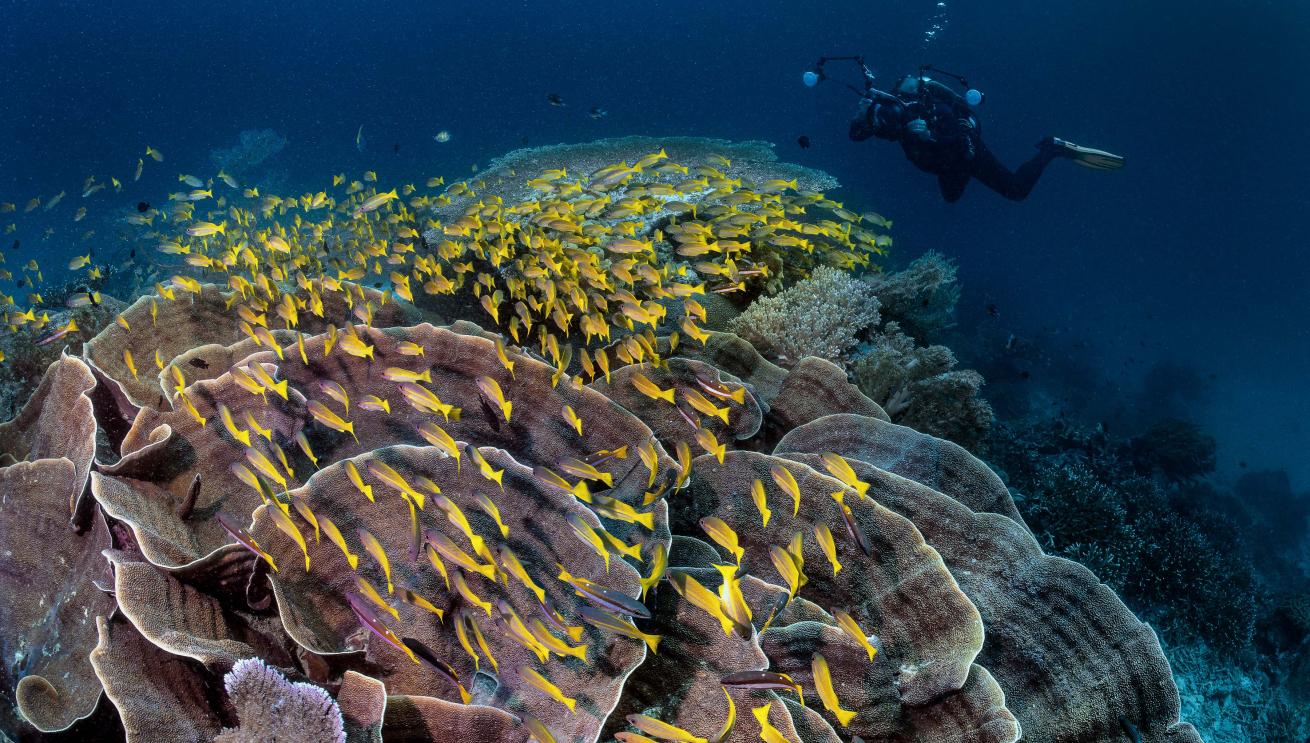
Mark B. HatterGetting the shot
At multiple dive sites we are treated to acre upon acre of hard coral stands. At one offshore location we enter the water at the face of a shallow plateau and ride the current seaward for nearly an hour over an endless, uninterrupted metropolis of corals flanked by ever-present fusiliers streaming around us. The current is strong and we are unable to completely stop to shoot images. But there is no point in stopping, the reef-top is uniformly continuous, changing only with different shapes and colors of corals representing impossible stands of different species.
So we go with the flow, shooting on the fly. As quickly as I flare my fins to brake my drift to frame Kevin in a shot, he disappears downstream from the pull of the current. No matter, in a couple of kicks I retrieve him at the edge of the visibility where he has braked to wait for me to reappear; it’s what photography buddies do.
After lunch we finish the day diving a pair of piers along a coral choked channel between two islands. The piers are havens for schooling snapper, sweetlips and sergeant majors. We stop to shoot as the afternoon wears on, but the current here eventually pulls from the structures and we sail along, past the gallery of hard corals replete with streams of fusiliers in the waning light.
We end yet another series of mind blowing dives in Central Raja but our dive guides remain temperate to our excitement. After all, it’s just another average day in the bullseye within the bullseye.

